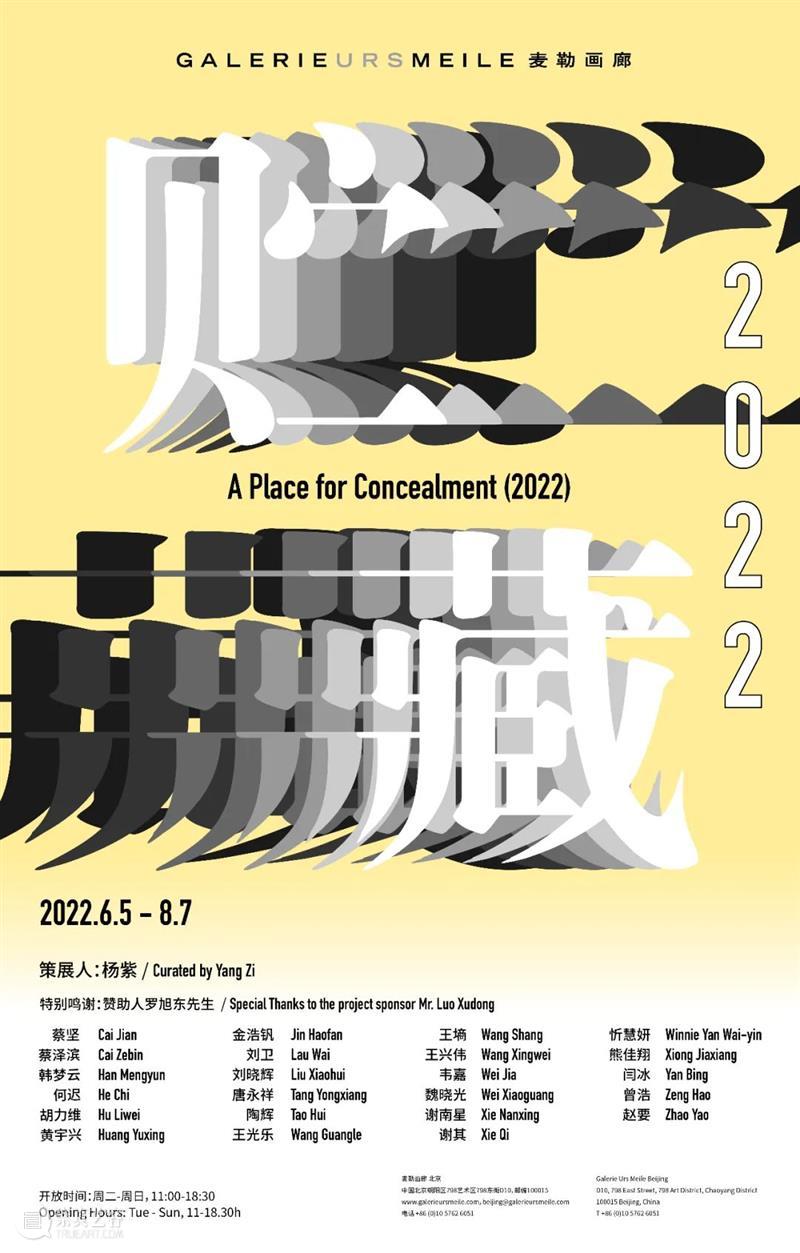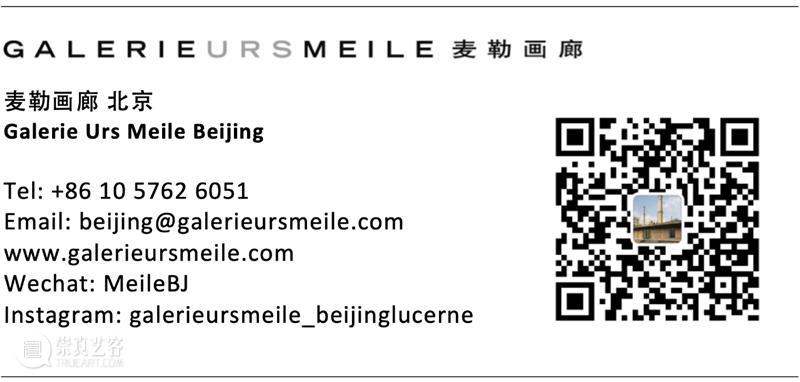

贮藏(2022)
A Place for Concealment (2022)
2022.6.5 - 8.7
策展人:杨紫
特别鸣谢:赞助人罗旭东先生
当前展览已对外开放
Current exhibition is now open to the public
麦勒画廊 北京
Galerie Urs Meile Beijing
(Please scroll down for English)
麦勒画廊北京荣幸地宣布我们即将举办最新展览“贮藏(2022)”,本次展览将呈现自1960年代至1990年代出生的二十余位中国当代艺术家的作品,囊括绘画、摄影、影像和装置等诸多媒介。本次展览由独立策展人杨紫策划。展览以两组画库的形式邀请观者一同进入遮掩的游戏中:艺术家将心理视像“贮藏”于作品的方寸之间——创作可以被视为一次激活这些视像的旅程,同时,他们也在等 待这些视像在凝视中被激活的时刻。心理视像浮现又消失,捕捉它们,是促成创作行动的一个理由。以身体的行动为中介,凭借着创作的展现,视像被委婉地传导给观看者——观众、收藏者,抑或艺术家本人,又在他们心中藏下了遥远的、模糊的起点,以期待下一次的瞄准与校正。
我们可以说,一位艺术家在创造作品的一个环节,是将所绘画的事物彻底地用心观看几遍。在对肉眼观看的模拟过程之中,艺术家是自由的,他/她可以围绕着绘画的对象旋转,进入它的内部,与之融为一体,或者将其分裂成粉末状的碎片。绘画的元素可以被调度成为一场戏剧的演员,它们随着艺术家的意志你来我往。抑或,流畅的被切断,分散的被联系起来,近的模糊了,远的清楚了,平面的立体了,坚实的扁平了。
我们不能说,心中的空间形象是被“腾挪”到现实中来的。这是因为,在将头脑中的物质化后,艺术家必须处理手上实在的材料,材料会反向塑造艺术家的心。心中的空间形象的呈现过程是一个与创造条件较量的过程。贮藏在心里的印象也是一个过程,它随着缓慢诞生、修正或变化的创造物时时刻刻地清晰起来。
本次展览也致敬于2019年王光乐在北京当代艺博会上组织的项目“作品的公寓——一个前置的货仓”。在这个项目中,王光乐集结了三十余位青年艺术家,将他们的作品紧密地悬挂在货仓内,观众需要通过抽拉每一层的“货仓”断面,才可以欣赏全貌。彼时,王光乐以这种形式比对北京艺术商业生态逐步抬头时的起步状态,短短几年后,同样的形式却能隐喻蓬勃的收藏行为下,艺术家被逐步消隐的主体性。
本次展览特别鸣谢青年藏家罗旭东先生,他对展览的鼎力支持让此项目得以实现。在因疫情被阻隔以及充满不确定性的当下,我们希望能通过这一汇聚不同代际艺术家、不同创作语言和艺术表达的展览开启一场对话。
Galerie Urs Meile is honored to announce our latest exhibition A Place for Concealment (2022). This exhibition will present works from more than twenty Chinese contemporary artists born from the 1960s to the 1990s, including works in painting, photography, video and installation. Curated by independent curator Yang Zi, this exhibition takes the form of two painting storage racks, inviting the viewer to enter a game of partial concealment: the artists “conceal” their mental visions within the confines of the artwork, and creation can be seen as a journey of activating these visions, but at the same time, they are awaiting the moment these visions are activated by the gaze. The psychological visions emerge and then disappear, and capturing them becomes an impetus for the act of creation. With the actions of the body as medium, revealed through creation, the vision is tactfully transmitted to the viewer—to the audience, to the collector, or to the artist himself—while also planting a distant, indistinct origin point in their minds, awaiting the next act of targeting and correction.
One could say that one aspect of the process of creating an artwork is for the artist to thoroughly observe the object of depiction multiple times in their mind. In the process of modeling what they see with the naked eye, the artist is free, free to move around the object of depiction, to enter it, to fuse with it, or to break it down into fragments. The elements of painting can be employed as actors in a play, interacting according to the artist’s will. What is fluid can be cut off, what is scattered can be linked together, the near made blurry, the distant made clear, the flat given depth, the solid rendered flat.
We cannot say that the spatial image in the mind is “transposed” into reality. That is because when the contents of the mind are materialized, the artist must deal with the material of reality, and that material in turn shapes the artist’s mind. The process of presenting the mind’s spatial image is a process of contention with the conditions of creation. The impression concealed within the mind is also a process—the created object takes on increasing clarity as it is gradually born, revised, or transformed.
This exhibition is also a tribute to artist Wang Guangle’s project Artwork Apartment—A Presupposed Storage Rack at the 2019 Beijing Contemporary Art Fair. In this project, Wang Guangle brought together over thirty young artists, and hung their works close together in a storage rack. Viewers had to pull each artwork out individually in order to take in the whole. At the time, this served as a metaphor for the growth of the nascent Beijing art business ecosystem. Within a few short years, the same form alludes to the vanishing subjectivity of the artist amidst the flourishing activity of art collecting.
We would like to express special thanks to young collector Mr. Luo Xudong, whose strong support made this project possible. In a time filled with obstacles and uncertainty due to the pandemic, we hope that this gathering of artists from different generations and artworks of different creative languages and artistic expressions can initiate a discussion.
关于策展人
About the Curator
杨紫,独立策展人,毕业于南京大学哲学系、宗教学系。他于2020年获选为首届“希克中国艺术研究资助计划”研究学人,并担任画廊周北京评委;2019年担任年度华宇青年奖初选评委;2017年入围 Hyundai Blue Prize 年度艺术大奖。
杨紫具有近十年的艺术评论写作及策展经验,2011年任《艺术界 LEAP》杂志编辑,并长期为《艺术界 LEAP》、《艺术论坛》中文网和《艺术新闻中文版》等杂志撰写文章。杨紫还曾任UCCA尤伦斯当代艺术中心策展人及公共项目总监,策划多场展览及公共项目活动,包括参与策划了“例外状态:中国境况与艺术考察2017”、“Pity Party”、“敢当:当代神石注疏”、“韶华”等群展,以及赵半狄、谢南星、张允菡、杨露子、尉洪磊、朱昶全等艺术家个展。
Yang Zi is an independent curator. He received his bachelor’s degree in philosophy and religious studies from Nanjing University. In 2020, he was awarded the first Sigg Fellowship for Chinese Art Research; he was the jury member of 2020 Gallery Weekend Beijing; in 2019 he served as one of the primary judges of Huayu Youth Award; he was a finalist for the 2017 Hyundai Blue Prize.
Yang Zi has nearly ten years of experience in art critic writing and curation. In 2011, he served as editor of LEAP, and wrote extensively for a range of publications such as LEAP, Artforum China and the Art Newspaper China. He was the curator and the head of Public Programs in UCCA. He curated numerous exhibitions and public programs, including “The New Normal: Art and China in 2017”, “Pity Party”, “Land of the Lustrous”, “In Younger Days”, and other projects, as well as solo exhibitions by artists such as Zhao Bandi, Xie Nanxing, Zhang Yunhan, Yang Luzi, Yu Honglei, and Zhu Changquan.
参展艺术家
Participating Artists
蔡坚、蔡泽滨、韩梦云、何迟、胡力维、黄宇兴、金浩钒、刘卫、刘晓辉、唐永祥、陶辉、王光乐、王墒、王兴伟、韦嘉、魏晓光、谢南星、谢其、忻慧妍、熊佳翔、闫冰、曾浩、赵要
Cai Jian, Cai Zebin, Han Mengyun, He Chi, Hu Liwei, Huang Yuxing, Jin Haofan, Lau Wai, Liu Xiaohui, Tang Yongxiang, Tao Hui, Wang Guangle, Wang Shang, Wang Xingwei, Wei Jia, Wei Xiaoguang, Xie Nanxing, Xie Qi, Winnie Yan Wai-yin, Xiong Jiaxiang, Yan Bing, Zeng Hao, Zhao Yao



已展示全部
更多功能等你开启...





 分享
分享